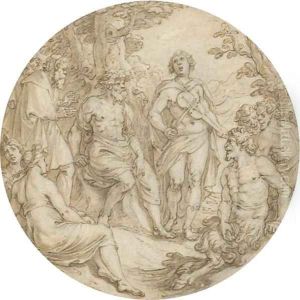Pieter I De Jode Paintings
Pieter de Jode I was a notable figure in the world of art, born in Antwerp in 1570. He was a member of an artist family that made significant contributions to the printmaking arena in the late 16th and early 17th centuries. Coming from a lineage of artists, De Jode was the son of Gerard de Jode, a well-known engraver and publisher. Pieter inherited his father's artistic inclinations, which led him to become an engraver and printmaker himself.
De Jode’s career flourished in the vibrant cultural scene of Antwerp, which was a major center for the arts during the Dutch Golden Age. He became a master in the Antwerp Guild of Saint Luke in the year 1589, marking his professional recognition as an artist. He was also involved in the publication of his father’s cartographic works, notably the 'Speculum Orbis Terrae', an atlas that competed with Ortelius’s 'Theatrum Orbis Terrarum'.
Although much of Pieter de Jode I’s life was overshadowed by the fame of his contemporaries such as the Sadeler family and Hendrick Goltzius, his works were nonetheless influential. His engravings included portraits and religious subjects, which were widely disseminated and contributed to the spread of artistic ideas across Europe. De Jode's style was characterized by a fine technique and a keen eye for detail, which can be seen in his delicate handling of textures and light in his prints.
His legacy continued through his descendants, most notably his son, Pieter de Jode II, who also became an accomplished engraver. The De Jode family's body of work is an important part of the history of printmaking, and their prints are still studied and collected today. Pieter de Jode I passed away in Antwerp in 1634, leaving behind a body of work that remains a testament to his skill and the artistic vibrancy of the period in which he lived.
